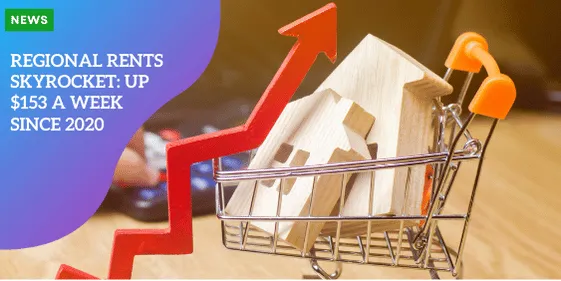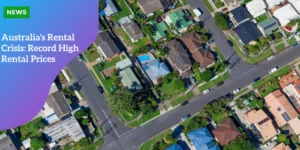Regional Rents Skyrocket: Up $153 a Week Since 2020

The Escalation of Rent Prices in Regional Australia
In a concerning trend for tenants across regional Australia, average rental prices have surged by $153 weekly since June 2020.
This sharp rise translates to an additional financial burden of $677 per month or a staggering $8,000 annually, highlighting the mounting pressure on household budgets.
Regional Disparities: Northern Western Australia Leads with a $481 Surge
Among the regions experiencing the most significant hikes, Northern Western Australia stands out with a staggering $481 increase in weekly rents.
This substantial rise underscores the acute challenges faced by residents in this part of the country.
Impact on Specific Regions
Queensland’s Gold Coast: A $363 Weekly Spike
Queensland’s Gold Coast has not been spared from the rental price surge, where tenants now contend with an average increase of $363 per week compared to mid-2020.
This escalation has far-reaching implications for affordability in one of Australia’s popular coastal regions.
South West WA: Rents Surge by $262 Weekly
Meanwhile, South West WA has seen its rental rates surge by $262 weekly.
This region, known for its natural beauty and lifestyle appeal, is grappling with escalating housing costs that threaten local residents’ economic stability.
Data Insights from Everybody’s Home
These findings come from an analysis conducted by Everybody’s Home, released ahead of its final hearing of the People’s Commission into Australia’s housing crisis.
The report sheds light on the widespread impact of rising rents, affecting various demographics and geographical areas across the nation.
State Disparities: Queensland and Western Australia Highlighted
Queensland and Western Australia emerge prominently in the list of top ten regional areas experiencing the highest rental increases.
Areas such as NSW’s Central Coast, Wollongong, and Hunter Region also feature prominently, with weekly rent hikes of $217, $199, and $183 respectively.
Commissioner’s Perspective on the Housing Crisis
Commissioner Doug Cameron, a former Labor senator, expressed grave concern over the profound economic implications of these price hikes, emphasizing that Australia’s housing dilemma affects every corner of the country.
He called for decisive action from policymakers to address the housing crisis comprehensively.
Advocacy from Everybody’s Home
Maiy Azize, spokeswoman for Everybody’s Home, criticized decades of governmental neglect that have exacerbated rent hikes in regional areas.
She highlighted the urgent need for policies that prioritize social housing and curtail tax incentives for investors, aiming to alleviate the housing strain on Australians nationwide.
Expert Insights: University of Sydney’s Perspective
Nicole Gurran, housing expert from the University of Sydney, underscored the disproportionate impact on First Nations communities due to housing supply failures.
She noted that escalating costs in once-affordable regional areas and increased vulnerability during disasters are critical issues that require immediate attention.
Community Impact and Solutions
Gurran, drawing from personal experience in Lismore, highlighted the stark reality of housing insecurity exacerbated by natural disasters.
She stressed the importance of community-driven solutions and firsthand experiences in shaping effective policies that cater to regional, remote, and First Nations communities.
Societal Consequences: Cutting Back on Essentials
Recent research by Everybody’s Home has illuminated the drastic measures Australians are taking to cope with rising housing costs.
Many households have resorted to reducing energy consumption, skipping essential medical appointments, and even cutting back on meals to make ends meet.
Conclusion: Urgent Need for Policy Reform
In conclusion, the sharp rise in regional rents across Australia demands immediate policy responses that prioritize affordability and housing security for all.
The insights provided by Everybody’s Home and experts like Nicole Gurran underscore the urgent need for inclusive solutions that address the diverse needs of regional, remote, and vulnerable communities.
Looking Ahead
As discussions intensify and policymakers deliberate, the primary objective continues to be the implementation of sustainable measures.
These measures aim to alleviate the effects of rent hikes and ensure fair access to housing for Australians, irrespective of their geographical location or socioeconomic standing.
As the debate intensifies and policymakers weigh their options, the focus remains on implementing sustainable measures that mitigate the impact of rent increases and ensure equitable access to housing for all Australians.
This could involve a multi-faceted approach, including:
- ✅ Increased investment in social and affordable housing initiatives: This would provide more rental options at subsidized rates, particularly for low-income earners and vulnerable populations.
- ✅ Introducing rental caps or rent freezes: While these measures have sparked debate, they can provide temporary relief for renters facing significant price hikes.
- ✅ Incentivizing new developments: This could include tax breaks or other concessions for developers who construct affordable housing units.
- ✅ Strengthening renter protections: This might involve implementing stricter rules around eviction notices, repairs, and tenant rights.
Ultimately, the goal is to create a housing system that is not only stable and affordable but also fosters a sense of security and well-being for all Australians.
Striking a balance between supporting renters and ensuring a healthy rental market will be crucial in finding a long-term solution to this complex issue.






